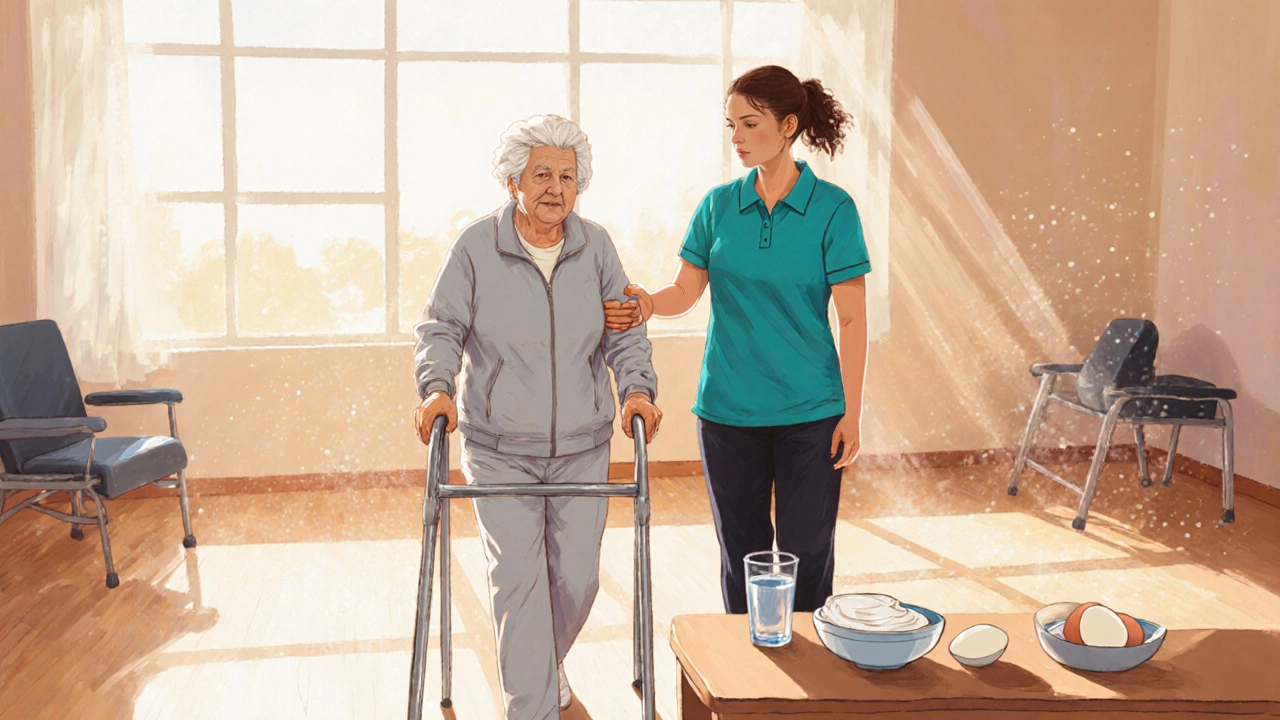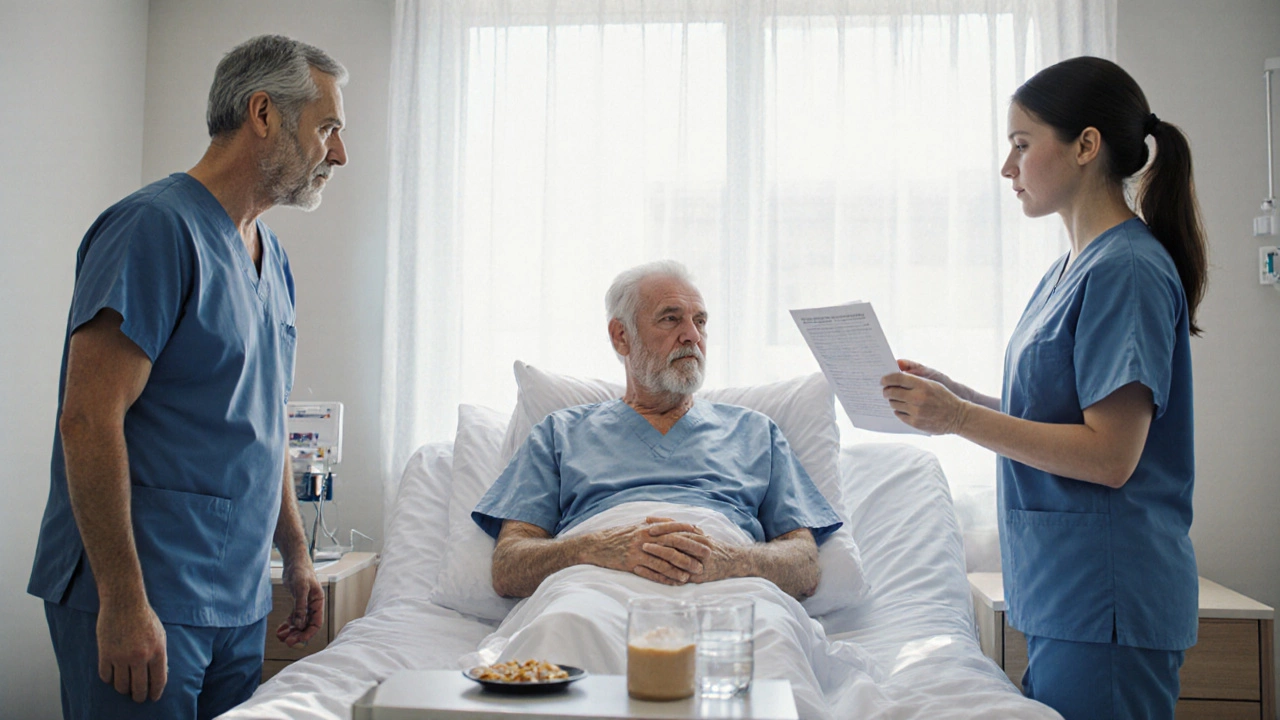Knee Surgery Recovery Timeline Calculator
Your Recovery Estimate
Recovery Timeline Breakdown
Recovery Factors
- 1 Age-related factors affect healing speed
- 2 Type of surgery determines initial recovery
- 3 Pre-existing conditions impact timeline
- 4 Adherence to physical therapy is crucial
- 5 Nutrition and hydration support healing
When a 70‑year‑old faces knee surgery, the biggest question is usually, "How long will it take to get back on my feet?" The answer isn’t a one‑size‑fits‑all number; it depends on the type of procedure, the patient’s overall health, and the support system in place. Below we break down the typical recovery phases, the factors that can speed up or slow down healing, and practical tips to make the journey smoother.
Understanding the Core Concept
knee surgery recovery is the process by which a patient regains mobility, strength, and comfort after an operation on the knee joint. For a 70‑year‑old, this journey often includes a hospital stay, staged rehabilitation, and careful monitoring for complications.
Key Factors That Influence Recovery Time
- Age itself doesn’t dictate a fixed timeline, but tissue elasticity and muscle mass tend to decline with years, affecting how quickly the body repairs.
- Type of Knee Surgery matters a lot. Total knee replacement, partial replacement, and arthroscopic procedures each have their own rehab protocols.
- Pre‑existing Health Conditions such as diabetes, heart disease, or osteoporosis can extend the healing phase.
- Physical Therapy Adherence is a major driver of functional recovery. Missing sessions or avoiding exercises can add weeks.
- Nutrition and Hydration provide the building blocks for tissue repair. Protein intake of 1.2‑1.5g/kg body weight is often recommended.
Typical Timeline for a 70‑Year‑Old After Knee Replacement
- Hospital Stay (Day 0‑2): Most patients are discharged within 24‑48hours after a total knee replacement. Pain is managed with multimodal analgesia, and early mobilization begins.
- First Week (Day 3‑7): Gentle range‑of‑motion exercises, short walks with a walker, and swelling control techniques such as ice and compression. Most can achieve 0‑90° flexion.
- Weeks 2‑6: Structured Physical Therapy sessions three times a week focus on strengthening quadriceps and hamstrings, progressing to stair climbing and light household chores.
- Weeks 6‑12: Pain usually subsides, and patients can often drive (if not on narcotics) and return to low‑impact activities like swimming or stationary cycling.
- Months 3‑6: Full functional recovery may take up to six months. By this stage, many seniors can resume most daily activities without assistance, though high‑impact sports remain off‑limits.

Comparison of Recovery Times by Procedure Type
| Procedure | Average Hospital Stay | Full Weight‑Bearing | Typical Return to Daily Activities |
|---|---|---|---|
| Total Knee Replacement | 1‑2 days | Day 2‑3 | 3‑6 months |
| Partial Knee Replacement | 1 day | Day 1‑2 | 2‑4 months |
| Arthroscopic Meniscectomy | Outpatient | Same day | 4‑6 weeks |
Practical Tips to Speed Up Recovery
- Start Moving Early: Even gentle ankle pumps and quad sets on the day of surgery reduce swelling and promote circulation.
- Follow the Rehab Protocol: Attend every physical therapy session; ask the therapist for a home‑exercise sheet you can follow.
- Manage Pain Wisely: Use prescribed NSAIDs and acetaminophen as directed. Over‑reliance on opioids can delay mobilization.
- Stay Hydrated and Eat Protein‑Rich Foods: Greek yogurt, eggs, lean meat, and legumes help rebuild muscle.
- Monitor for Red Flags: Sudden increase in pain, fever, calf swelling, or inability to move the knee should trigger a call to your Orthopedic Surgeon.
Common Post‑Operative Complications and How to Address Them
Complications are relatively rare but worth knowing:
- Infection: Affects roughly 1‑2% of knee replacements. Watch for redness, warmth, and fever. Early antibiotics are key.
- Blood Clots (DVT): Older adults have a higher risk. Compression stockings and short‑term blood thinners reduce incidence.
- Stiffness: If knee flexion stalls below 90°, additional therapy or a brief course of corticosteroid injection may help.
- Implant Loosening: Typically a long‑term issue, but persistent pain after the 6‑month mark warrants imaging.

When to Seek Professional Help
Even with diligent rehab, some signs call for immediate medical attention:
- Uncontrolled pain despite medication.
- Increasing swelling or a hot, red knee.
- Sudden inability to bear weight.
- Fever above 38°C (100.4°F) that doesn’t subside.
Contact your surgeon or go to the nearest emergency department if any of these appear.
Setting Realistic Expectations
Recovery is a marathon, not a sprint. Most 70‑year‑olds regain enough function to walk unaided within three months, but true strength and confidence in the joint often need six months of consistent effort. Understanding that setbacks-like a sore calf or a temporary flare of arthritis-are normal can keep frustration at bay.
Bottom Line
For a 70‑year‑old, the average timeline to feel comfortable after a total knee replacement is about 12‑16 weeks for basic daily tasks, extending to six months for high‑function activities. Individual results vary, but adhering to the rehab plan, managing pain, and staying proactive about nutrition dramatically improve outcomes.
Frequently Asked Questions
How long does a 70‑year‑old stay in the hospital after knee replacement?
Most patients are discharged within 24‑48hours, provided pain is controlled and they can safely ambulate with a walker.
Can I drive after knee surgery at age 70?
Driving is usually cleared once you can achieve at least 90° knee flexion and no longer need narcotic pain meds, typically around 6‑8 weeks post‑op.
What exercises are safest in the first two weeks?
Quad sets, ankle pumps, heel slides, and short assisted walks are recommended. High‑impact or resistance band work should wait until week 3.
Is a partial knee replacement better for faster recovery?
Partial replacement often leads to a shorter hospital stay and quicker return to light activities (2‑4 months), but it’s only suitable when the damage is limited to one compartment of the joint.
What nutrition should I prioritize?
Focus on lean protein, calcium‑rich foods, vitaminD, and omega‑3 fatty acids. Aim for 30‑40g of protein per meal to support muscle repair.





